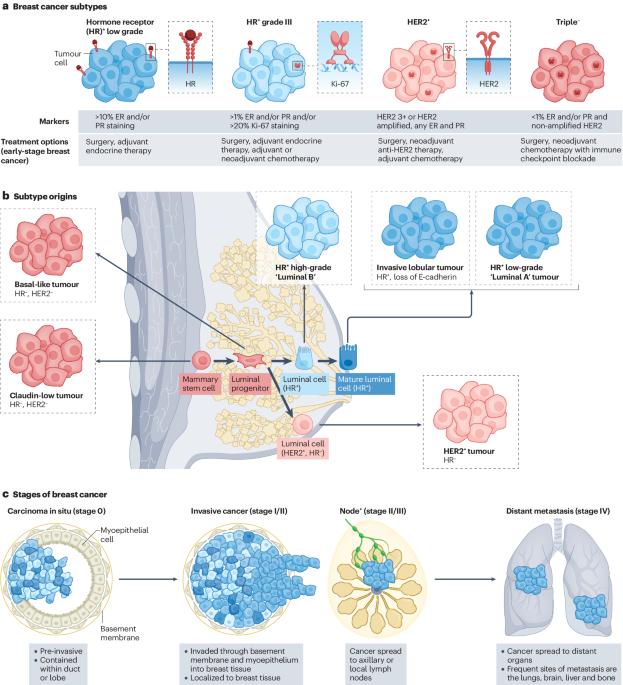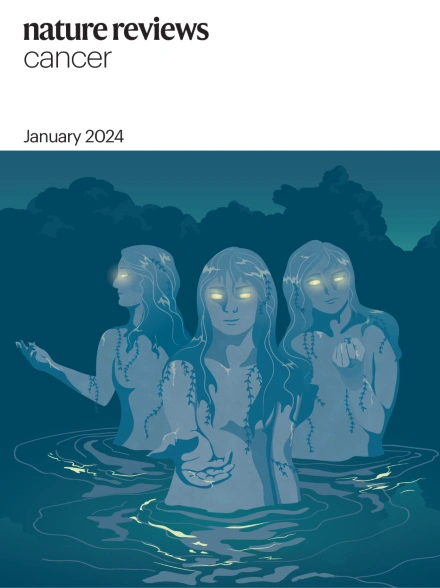Towards targeting the breast cancer immune microenvironment
IF 66.8
1区 医学
Q1 ONCOLOGY
引用次数: 0
Abstract
The tumour immune microenvironment is shaped by the crosstalk between cancer cells, immune cells, fibroblasts, endothelial cells and other stromal components. Although the immune tumour microenvironment (TME) serves as a source of therapeutic targets, it is also considered a friend or foe to tumour-directed therapies. This is readily illustrated by the importance of T cells in triple-negative breast cancer (TNBC), culminating in the advent of immune checkpoint therapy in combination with cytotoxic chemotherapy as standard of care for both early and advanced-stage TNBC, as well as recent promising signs of efficacy in a subset of hormone receptor-positive disease. In this Review, we discuss the various components of the immune TME in breast cancer and therapies that target or impact the immune TME, as well as the complexity of host physiology. In this Review, Harris et al. summarize the dynamic changes of the immune breast tumour microenvironment (TME) that take place during disease progression and in response to treatment, and outline emerging therapies to target the immune TME in patients with breast cancer.


以乳腺癌免疫微环境为目标。
肿瘤免疫微环境是由癌细胞、免疫细胞、成纤维细胞、内皮细胞和其他基质成分之间的相互作用形成的。尽管肿瘤免疫微环境(TME)是治疗靶点的来源,但它也被认为是肿瘤定向疗法的敌人或朋友。T细胞在三阴性乳腺癌(TNBC)中的重要性就很好地说明了这一点,免疫检查点疗法与细胞毒化疗的联合应用最终成为治疗早期和晚期TNBC的标准疗法,最近还有迹象表明该疗法在激素受体阳性疾病中的疗效很好。在本综述中,我们将讨论乳腺癌免疫TME的各个组成部分、针对或影响免疫TME的疗法以及宿主生理学的复杂性。
本文章由计算机程序翻译,如有差异,请以英文原文为准。
求助全文
约1分钟内获得全文
求助全文
来源期刊

Nature Reviews Cancer
医学-肿瘤学
CiteScore
111.90
自引率
0.40%
发文量
97
审稿时长
6-12 weeks
期刊介绍:
Nature Reviews Cancer, a part of the Nature Reviews portfolio of journals, aims to be the premier source of reviews and commentaries for the scientific communities it serves. The correct abbreviation for abstracting and indexing purposes is Nat. Rev. Cancer. The international standard serial numbers (ISSN) for Nature Reviews Cancer are 1474-175X (print) and 1474-1768 (online). Unlike other journals, Nature Reviews Cancer does not have an external editorial board. Instead, all editorial decisions are made by a team of full-time professional editors who are PhD-level scientists. The journal publishes Research Highlights, Comments, Reviews, and Perspectives relevant to cancer researchers, ensuring that the articles reach the widest possible audience due to their broad scope.
 求助内容:
求助内容: 应助结果提醒方式:
应助结果提醒方式:


